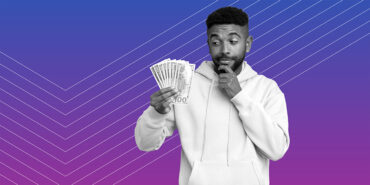How to Calculate the Cost of Your Cash Advance

Using a credit card can be a smart decision if you do so responsibly. In fact, there are actually many benefits to sensible credit card utilization: you can use them to build up a bad credit score, earn cash back and signup bonus rewards, and even finance major purchases without interest during introductory periods.
However, credit cards can be a double-edged sword. One side has the ability to pull you out of a bad credit slump and improve your financial life, and the other can tank your credit score and put you in a cycle of debt. It all depends on how you use it.
According to the Federal Reserve Bank of New York, total U.S. credit card debt stood at $1.12 trillion in Q1 2024. That's a lot of debt on a lot of credit cards!
And OH BOY are there quite a few ways to use a credit card poorly, as many Americans know all too well. While we all know that racking up a balance you can't pay off and maxing out your cards is bad for your financial health, one of the most expensive things you can do with a credit card—taking out a cash advance—isn't usually the first thing that comes to mind when you think of irresponsible credit card habits.
But the reality is, credit card cash advances can cost you some serious coin.
What is a cash advance?
A 'cash advance' can mean several different things. First, there are cash advance loans, which are essentially payday loans by another name. In order to get one, you will usually write a check to the lender, dated on your next payday, for the amount of your loan plus interest and, in exchange, the lender will give you the cash you need.
On your next payday, the lender will cash your check, and if you don't have enough money in the bank for the check to go through, you'll be stuck in a rollover cycle of debt, paying insanely high interest rates on what is often a relatively small amount of money.
Second, there are employer cash advances. Not all employers offer them, but if yours does, you may be able to request to receive a portion of your paycheck early. These kinds of cash advances typically don't carry interest, as you're only getting money that is owed to you a few weeks before you normally would.
In contrast, credit card cash advances are a whole different beast and a pricey one at that. While typically not quite as expensive as taking out a cash advance loan, credit card cash advances often come with hidden fees and interest.
Essentially, when you take out a credit card cash advance, you're using your credit card in the same way you would a debit card. You can go to an ATM or bank, and use your credit card to withdraw cash.
The difference between using a debit card to get cash and using a credit card to get cash? When you use a debit card, the money you're taking out is already yours. However, when you use a credit card to get a cash advance, that money isn't coming from your bank account.
Every time you use a credit card, you are taking out a small loan from your credit card company. If you pay back those loans in full every month, you can usually avoid paying interest on them.
But you can't avoid paying interest on a cash advance.
How much does a cash advance cost?
Not every credit card company allows cash advances, and for those that do, the rates can vary wildly. According to Forbes, the average Annual Percentage Rate (APR) for a cash advance hovers between 17.99% and 29.99%.
Additionally, while most credit cards offer a grace period in which you can pay off your balance without paying any interest on it, there is no grace period on a credit card cash advance. Interest will begin incurring the moment you take out the cash and will continue to build until you pay it back in full.
In addition, there's often a flat fee associated with credit card cash advances, typically between 3% and 8% of the total amount you take out. For example, if you take out a $1,000 cash advance with a 3% flat fee, you'll be paying an additional $30 on top of the interest that immediately starts accruing.
Let's go further with that hypothetical $1,000 cash advance. Let's say the APR for cash advances on your card is 24%, and the flat fee is 3%. If it takes you a month to pay back your cash advance, you will pay a total of $1,050 when all is said and done. You're paying $50 for the privilege of having cash on hand; a high price to pay, no matter how convenient it is.
If instead, you just made a $1,000 purchase on your credit card and paid it back within the grace period, that $50 would still be in your pocket waiting to be put into savings or spent on a nice dinner out.
How do I calculate the total cost of my cash advance?
To calculate how much a cash advance will cost, pull out your credit card contract and locate the interest and fees your lender charges for a cash advance. Once you find that information, plug it into this equation:
Your monthly interest owed = ((the amount you're borrowing x (APR/100))/365) + the flat fee.
In the case of the $1,000 cash advance with the 24% APR, it would look like this:
$1,000 x .24 = $240, or the total amount of interest you'd pay on this if it took you a year to pay it back.
240/365 = $0.65, or the total amount of interest you're paying on this cash advance every day you don't pay it back.
So, if you took a week to pay back this $1,000 cash advance, it would cost you $4.60 in interest ($0.65x7), and $30 for the flat fee. In total, you would pay $1,034.60 on that $1,000 cash advance.
Is there ever a good time to take out a credit card cash advance?
In short, no. If you need cash, there are a few other options you should explore before heading over to the nearest ATM with your credit card in tow.
Instead, consider using a digital payment app like Cash App, Venmo, or Paypal to send people money instead of paying them in cash. In this new modern world, even farmers and flea market vendors often accept digital payments.
If you find yourself frequently needing paper bills, make sure to take out a portion of your paycheck in cash whenever you deposit it. That way you won't have to pay ATM or cash advance fees when you head out to your favorite cash-only restaurant.
Even writing a check and taking it to a check-cashing store is a better option than taking out a credit card cash advance. You'll still have to pay a fee to get your cash, but you won't be charged any interest.
If you find yourself in an emergency situation where a cash advance is your only option, just remember to do the math first. Calculate exactly how much the cash advance will cost, and budget ways to pay it back as quickly as possible.
In general, you deserve better than a costly cash advance.
Please note the below article contains links to external sites outside of OppU and Opportunity Financial, LLC. These sources, while vetted, are not affiliated with OppU. If you click on any of the links you will be sent to an external site with different terms and conditions that may differ from OppU’s policies. We recommend you do your own research before engaging in any products or services listed below. OppU is not a subject matter expert, nor does it assume responsibility if you decide to engage with any of these products or services.



